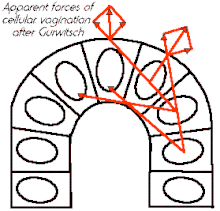Morphogenetic field

In thedevelopmental biologyof the early twentieth century, amorphogenetic fieldis a research hypothesis and a discrete region of cells in anembryo.[1][2]
The termmorphogenetic fieldconceptualizesthe scientific experimental finding that an embryonic group ofcells,for example a forelimb bud, could be transplanted to another part of the embryo and in ongoingindividual developmentstill give rise to a forelimb at an odd place of the organism. And it describes a group of embryoniccellsable to respond to localizedbiochemicalsignals − calledfield− leading to thegenesisofmorphologicalstructures:tissues,organs,or parts of anorganism.[3][4]
Thespatialandtemporalextents of such a region ofembryonic stem cellsare dynamic, and within it is a collection of interacting cells out of which a particular tissue, organ, or body part is formed.[5] As a group, the cells within amorphogenetic fieldin an embryo are constrained: thus, cells in alimb fieldwill become a limb tissue, those in aheartfieldwill become heart tissue.[6] Individual cells within amorphogenetic fieldin an embryo are flexible: thus, cells in acardiac fieldcan be redirected via cell-to-cell signaling to replace damaged or missing cells.[6]
TheImaginal discinlarvaeis an example of a discretemorphogenetic fieldregion of cells in an insect embryo.[7]
History[edit]
- Early concept development
The concept of the morphogenetic field was first introduced in 1910 byAlexander G. Gurwitsch.[1]Experimental support was provided byRoss Granville Harrison's experiments transplanting fragments of a newt embryo into different locations.[8]
Harrison was able to identify "fields" of cells producing organs such as limbs, tail and gills and to show that these fields could be fragmented or have undifferentiated cells added and a complete normal final structure would still result. It was thus considered that it was the "field" of cells, rather than individual cells, that were patterned for subsequent development of particular organs. The field concept was developed further by Harrison's friendHans Spemann,and then byPaul Weissand others.[5]The concept was similar to the meaning of the termentelechyof vitalists likeHans Adolf Eduard Driesch(1867–1941). Thus thefield hypothesis ofontogenybecame fundamental in the early twentieth century to the study of embryological development.
- Rise of modern genetics
By the 1930s, however, the work of geneticists, especiallyThomas Hunt Morgan,revealed the importance of chromosomes and genes for controlling development, and the rise of thenew synthesisin evolutionary biology lessened the perceived importance of thefieldhypothesis.Morgan was a particularly harsh critic of fields since the gene and the field were perceived as competitors for recognition as the basic unit ofontogeny.[5]With the discovery and mapping of master control genes, such as thehomeoboxgenes which were first discovered in 1983, the pre-eminence of genes seemed assured.
- Rediscovery of the field concept
In the late twentieth century thefield concept of ontogenesiswas "rediscovered" as a useful part of developmental biology. It was found, for example, that different mutations could cause the same malformations, suggesting that the mutations were affecting acomplex of structuresas a unit, aunitthat might correspond to thefieldof early 20th century embryology. In 1996Scott F. Gilbertproposed that the morphogenetic field was a middle ground between genes and evolution.[5]That is, genes act uponfields,which then act upon the developing organism.[5]Then in 2000 Jessica Bolker describedmorphogenetic fieldsnot merely as incipient structures or organs, but as dynamic entities with their own localized development processes, which are central to the emerging field ofEvolutionary developmental biology( "evo-devo" ).[9]
- Decline of the concept
In 2005,Sean B. Carrolland colleagues mentionmorphogenetic fieldsmerely as aconceptproposed by early embryologists to explain the finding that a forelimb bud could be transplanted and still give rise to a forelimb; they define "field" simply as "a discrete region" in an embryo.[2]
References[edit]
- ^abBeloussov, LV (1997)."Life of Alexander G. Gurwitsch and his relevant contribution to the theory of morphogenetic fields".International Journal of Developmental Biology.41(6): 771–779.PMID9449452.[permanent dead link],with comment by SF Gilbert and JM Optiz.
- ^abCarroll, Sean B.;Grenier, Jennifer K.; Weatherbee, Scott D. (2005).From DNA to Diversity: Molecular Genetics and the Evolution of Animal Design(2nd ed.). Blackwell. pp. 20, 242.ISBN978-1-4051-1950-4.
- ^Alberts B, Johnson A, Lewis J, Raff M, Roberts K, Walter P (2002).Universal Mechanisms of Animal Development.in:Molecular Biology of the Cell(4th ed.). Garland.ISBN978-0-8153-3218-3.
- ^Jacobson AG, Sater AK (1 November 1988)."Features of embryonic induction".Development.104(3): 341–59.doi:10.1242/dev.104.3.341.PMID3076860.
- ^abcdeGilbert SF, Opitz JM, Raff RA (1996)."Resynthesizing evolutionary and developmental biology".Dev. Biol.173(2): 357–72.doi:10.1006/dbio.1996.0032.PMID8605997.
- ^abGilbert SF (2003).Developmental biology(7th ed.). Sunderland, Mass: Sinauer Associates. pp. 65–6.ISBN978-0-87893-258-0.
- ^Alberts B, et al. (2002).Organogenesis and the Patterning of Appendages.in:Molecular Biology of the Cell(4th ed.). Garland.ISBN978-0-8153-3218-3.
- ^de Robertis, EM; Morita, EA; Cho, KWY (1991)."Gradient fields and homeobox genes"(PDF).Development.112(3): 669–678.doi:10.1242/dev.112.3.669.PMID1682124.
- ^Bolker, JA (2000). "Modularity in Development and Why It Matters to Evo-Devo".American Zoologist.40(5): 770–776.CiteSeerX10.1.1.590.6792.doi:10.1668/0003-1569(2000)040[0770:MIDAWI]2.0.CO;2.S2CID198157009.
Further reading[edit]
- Davidson EH (1 July 1993)."Later embryogenesis: regulatory circuitry in morphogenetic fields".Development.118(3): 665–90.doi:10.1242/dev.118.3.665.PMID7915668.
- Gilbert SF (2006)."The" Re-discovery "of Morphogenic Fields.in:DevBio: a companion to Developmental Biology, 8th ed ".Sinauer Associates. Archived fromthe originalon 2007-06-09.Retrieved2007-07-20.
External links[edit]
- See a morphogenetic field model and simulation at: Lahoz-Beltra, R., Selem Mojica, N., Perales-Gravan, C., Navarro, J., Marijuan, P.C., 2008. Towards a Morphogenetic Field Theory.[1]
